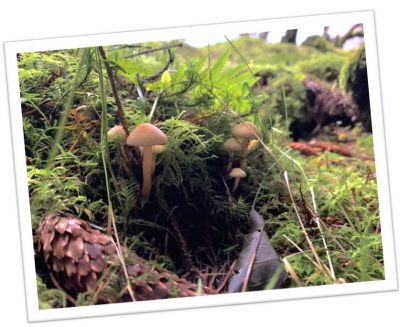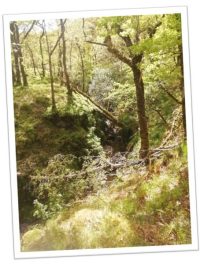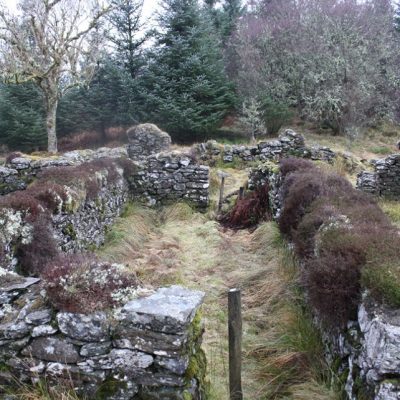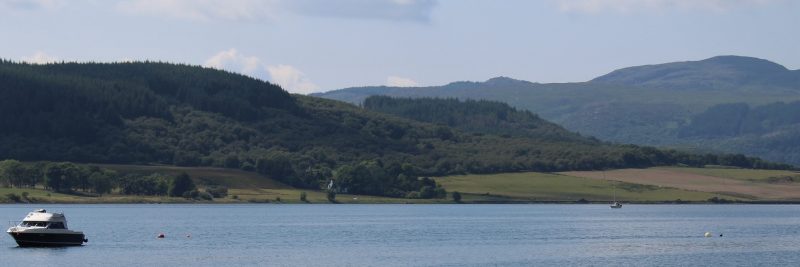Balnakailly Wood

Bute Community Forest incorporates part of the old Atlantic Rain Forest and the best example of this is the extensive old oak forest above the Balkanailly Burn. A designated Site of Special Scientific Interest (SSSI), the old oak woodland is a mature woodland home to a rich variety of flora and fauna, from lichens and mosses to butterflies, birds and rare wood ants.
Take the short walk from Rhubodach Ferry across farmland to the Balkanailly Burn bridge and then take one of the two marked paths up through the Old Oak Forest. Take the left hand path up alongside the Balkanailly Burn past ancient oaks and on to the Balkanailly settlement, or take the right hand path that meanders through the oaks and through the small plantation area until it too reaches the Balkanailly settlement.

Over the years, deer have grazed at ground level and the understorey is perhaps not as rich and diverse as it could be. Those involved with the Bute Community Forest are conscious of this and are actively seeking to manage the Old Oak Forest to allow new growth and to preserve the Atlantic Rainforest for future generations.

This deserted farm lies within the former Forest of Bute which was a royal forest in the 15th century. The ancient oak woodland lying to the east formed the core of this forest.
There are five building ruins, a garden and an enclosure visible to this day. The largest farm building is a good example of traditional building practices, with three cruck slots visible in the walls. These would have stabilised the large timber beams which supported the roof.
Census entries suggest a large majority of residents left in the 1840's with the settlement finally abandoned in the 1860's. Some of the family names associated with the settlement are still familiar on Bute today: Fisher, McKay, Gordon, McArthur, McFie, McKellar, Ferguson and McLachlan.
The land passed to Bute Estate in 1781. In 2010 Balnakeilly farmstead was included in a community land purchase of the surrounding forest and is now owned by the people of Bute through us, Bute Community Land Company.
If you want to find out more about the history of Bute you can visit Bute Museum.
The Bunker: Operation Starfish
The forest contains evidence of a decoy site built in World War II. Decoy sites were built to fool German bombers into attacking a place which had no civilians and were of no military value instead of their real targets. The concrete bunker below is one of three in the forest which would have controlled lights and set off trails of fire throughout the area. This would have looked from the air like an airfield or other important military base. It was unsuccessful on Bute and the forest was never bombed.
There is more information on an interpretation board at the site, thanks to the People’s Postcode Trust.

A lovely short walk taking in oak woodland and spruce, passing the Painted Rock Trail and work area and with a short diversion, taking you to the stunning viewpoint at the WW2 bunker.
The Balnakailly Woodland is the most northern part of the forest and takes you to the most northern part of the island. The Balnakailly loop, a partnership between Bute Forest and the Discover Bute Landscape Partnership Scheme takes you through both parts of the woodland and can be completed in part or in full. In full it is approximately 4 miles.
If walking the loop anti-clockwise then start at the Rhubodach – Colintraive ferry crossing and head north through the gate, across the field and take the stile into the woodland.
You’ll find a whole variety of wild flowers, ferns, mosses, lichens, fungi and animals depending on the time of year that you visit.
The path takes you through the oak woodland which is a Site of Special Scientific Interest, until you drop down over a small wall and though the line of spruce. A short walk through the spruce takes you to the Balnakailly settlement, the remains of a farmhouse and a peaceful, sheltered area.
You can then continue the loop along the forest track (easier walking and much less boggy!) until you reach the turning circle. A diversion here straight to the right of the signpost will take you across uneven ground to the WW2 bunker, where there are truly stunning views across the Kyles of Bute.
The little islands are the Burnt Isles and the hills are the mainland with Colintraive & Glendaruel in the forefront. You can access the WWII bunker viewpoint by taking the Balnakailly Loop path. The trail to the bunker is just off the turning circle closet to the Blankailly settlement. In spring, there are ground nesting birds in this area so please keep dogs on leads – however well behaved they are we don’t want them chasing parents away! In autumn, the area is littered with fungi. On the way, you’ll see one of our standing stones.
Head back to the forest track and continue along, taking in the odd clear view through the trees across the water..
You will come out onto the A886 next to Rhubodach Cottage and turn left and walk along the grass verge next to the road or along the shoreline back to the ferry terminal.
The Community Forest runs along the East Kyle of the Island of Bute and there is no better way to appreciate the Forest than from the water. Working with Argyll and Bute Council, the Community Forest houses facilities for kayakers at the north end of the island near Buttock Point. This forms part of the Argyll Sea Kayak Trail https://you-well.co.uk/argyll-sea-kayak-trail/.
The facilities at the Community Forest are a covered shelter with seating, information board, BBQ/firepit, composting toilet and flat area suitable for a small number of tents. Please take rubbish with you and leave the area as you find it as the Forest is run by volunteers and this area is fairly remote and inaccessible by foot.

We're excited to unveil our newest trail over at Balnakailly Oak Woodland highlighting some of the amazing birds you can find in the Community Forest!
If you want to learn more about the woodland birds you can follow our Birds in the Woods Trail in Balnakailly Woodland! Following this trail you'll see painted cut-outs of some of the birds the forest is home to and at each one there is a QR code that will give you more facts as well as letting you hear what the bird sounds like! And before you go out don't forget to download out Birds in the Woods Checklist or pick up a copy at Bute Discovery Centre.











